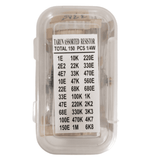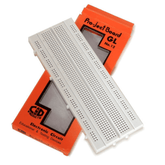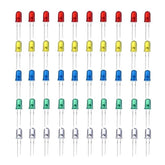Historical Evolution of Electronic Components
Summary
Explore the fascinating journey of electronic components in our blog, "Historical Evolution of Electronic Components." Begin with an insightful Introduction, delving into the origins of electronic technology. Witness the revolutionary transition through Early Electronic Components, followed by The Transistor Revolution that changed the game. Dive into the era of Integrated Circuits and Microprocessors, paving the way for modern advancements. Uncover the latest innovations in Modern Electronic Components, showcasing the dynamic evolution. Join us on this captivating journey, and discover the pivotal role these components play in shaping our digital world. Don't miss the exciting conclusion that ties it all together! Click here for a riveting exploration.
Introduction
Electronic components are integral to nearly every modern technology we interact with daily. From our smartphones and laptops to complex computing systems and medical devices, the inner workings of electronics enable our technologically driven world. The electronic components we rely on today have undergone a remarkable evolution from their early beginnings over a century ago. Tracing the historical development of electronic components provides insight into how far the industry has advanced.
Early innovators laid the groundwork for many of the electronic components we now take for granted. Their breakthroughs and discoveries have driven rapid progress in the field. As researchers uncovered new ways to harness electricity and electrons, they ushered in era-defining technologies. Each new phase in the evolution of electronic components enabled devices and systems of increasing complexity and capability.
Understanding the trajectory of this evolution provides perspective on how revolutionary concepts and components sparked incremental innovations. The transistor, integrated circuit, and microprocessor each served as catalysts that transformed what electronics could achieve. By examining key periods in the development of electronic components, we can follow the path that led to the remarkable digital world we inhabit today.

Early Electronic Components
The genesis of electronics traces back to pioneering work with electricity in the 18th and 19th centuries. Notable advances during this era include the electric battery, electromagnet, electric motor, and vacuum tube. Early researchers established the foundational principles that allowed for controlled use of electrical power. However, applying these principles to functional electronic devices and systems required the development of components for regulating and manipulating electricity.
The vacuum tube emerged as one of the first pivotal electronic components in the early 20th century. Invented in 1904 by John Ambrose Fleming, vacuum tubes could rectify and amplify electrical signals. They served as fundamental building blocks that enabled new applications like radio transmission and telephony. During their heyday from the 1920s to the 1940s, vacuum tubes were used extensively in consumer electronics like radios as well as industrial and military equipment.
Despite their versatility, vacuum tubes had significant limitations. They consumed considerable power, took time to warm up, and the glass enclosures made them fragile. The need for higher performance electronics during World War II fueled research into alternative electronic components not saddled with these weaknesses. This drive for miniaturization and reliability ultimately led to the transistor revolution.
The Transistor Revolution
Arguably one of the most important inventions of the 20th century, the transistor emerged as the successor to the vacuum tube. Invented at Bell Laboratories in 1947, the transistor significantly outperformed vacuum tubes in switching and amplifying electrical signals. Early transistors were made from germanium, but silicon models gained prominence in the 1950s. Their compact size, low power consumption, and absence of fragile glass parts made transistors dramatically superior to vacuum tubes.

The transistor enabled the rise of smaller, more efficient, and more reliable electronic devices. Hearing aids, pocket radios, and television sets all benefited greatly from incorporating transistors. The aerospace industry's adoption of transistors also accelerated, as their ruggedness and compact size proved ideal for space missions. By the 1960s, transistors had almost entirely replaced vacuum tubes in electronics.
Beyond their direct advantages over vacuum tubes, transistors served as the fundamental building block for integrated circuits - the next giant leap in electronic components. The concept of integrating multiple transistors and other elements onto a single silicon chip launched the era of microelectronics. The transistor thus fueled rapid development in electronics from the 1950s onward.
Integrated Circuits and Microprocessors
Building upon transistor technology, the integrated circuit (IC) emerged as the next breakthrough. Rather than connecting multiple discrete components together, ICs allowed transistors, capacitors, resistors, and diodes to be manufactured together on a small silicon chip. Initially developed for military applications in the 1950s, the first commercial ICs appeared in the early 1960s.
Jack Kilby at Texas Instruments and Robert Noyce at Fairchild Semiconductor independently devised the IC concept and produced early prototypes. From these modest beginnings, the density of components on integrated circuits grew exponentially over time. This laid the foundation for Moore's Law, which predicted that the number of transistors on ICs would double about every two years. The emergence of complementary metal-oxide semiconductor (CMOS) technology further fueled this miniaturization trend.

The microprocessor represented one of the most influential outcomes of integrated circuit technology. Introduced in 1971, the microprocessor incorporated key elements of a computer - like arithmetic logic units and control circuits - on a single IC. Microprocessors enabled small, low-cost, and versatile computing solutions that could be produced on a mass scale. Their adoption accelerated the digital revolution, powering early personal computers and a wave of innovative electronic devices.
Modern Electronic Components
The combined impact of transistors, integrated circuits, and microprocessors drove incredible progress in electronic components and systems over the late 20th century. Researchers found new ways to pack more functionality into ever-smaller packages. Several innovations that emerged from this include:
- Printed circuit boards (PCBs) - Fibreglass boards containing copper tracks to interconnect electronic components without wires. PCBs enable efficient, compact, and reliable construction of electronic circuits.
- Surface mount technology (SMT) - A method of attaching electronic components directly to the surface of PCBs rather than using holes. SMT helped further minimize the size of PCB assemblies.
- Field programmable gate arrays (FPGAs) - Integrated circuits that can be programmed after manufacturing. This allows a single FPGA design to be customized for different applications.
- Microelectromechanical systems (MEMS) - Microscopic devices that integrate mechanical and electrical elements on ICs. MEMS have enabled miniaturized sensors, actuators, and other devices.
- Nanoelectronics - Circuitry and components at the nanometer scale. Nanoelectronics promises to continue pushing the boundaries for smaller, faster, and more energy-efficient devices.
Emerging areas like printed electronics and molecular electronics may yield the next generation of electronic components. But the exponential progress predicted by Moore's Law is approaching fundamental limits imposed by physics. As shrinking reaches the atomic scale, researchers must look beyond simply making components smaller. Evolving materials, 3D architectures, and new paradigms will be needed to enable future progress.
Conclusion
The electronics revolution has been marked by a remarkable evolution of underlying components over just a century. Breakthrough innovations like the transistor and integrated circuit spawned successive waves of technological advancement. Each new class of electronic components enabled devices and systems of astonishing complexity compared to just decades prior.
Pioneers likely could not have envisioned the omnipresence of advanced electronics today. But their groundbreaking work established the foundation that made modern electronics possible. Tracing this developmental arc provides perspective on how today’s marvels emerged from humble beginnings. It also highlights how further progress relies on the next visionary electronic components that can transcend current technological limits.
The historical evolution of electronic components is a testament to persistent human ingenuity and the compounding nature of knowledge. Our civilization now rests upon sophisticated electronics embedded into nearly everything we use. Understanding the origins of these hidden enablers gives insight into the progress we often take for granted. Just as past achievements were built on prior innovations, the electronics breakthroughs of today will enable the next wave of revolutionary technologies tomorrow.













